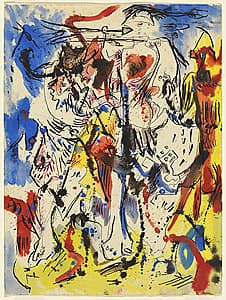

Jackson Pollock
Learn moreUntitled c.1944
© Pollock-Krasner Foundation. ARS/Copyright Agency Purchased 1985
More detail | PermalinkJackson Pollock was a patient of the Jungian psychologist Joseph Henderson: a treatment that coincided with the artist’s growing interest in Surrealism, and a concurrence of events that resulted in a creative outpouring. Between 1938 and 1943, Pollock produced numerous pictographic drawings based on striking symbolic motifs, including a cache of 83 drawings provided to Henderson as material for analytical aids.
Rendered in a restless, black ink line, a horse and its rider emerges as the central image of the drawing Untitled c#1944. The rider wears a helmet adorned with feathers, or perhaps tassels, while the horse strides from right to left across the picture plane, with stark white forelegs and solid hoofs. The abstract background is a tangle of undefined areas of blue and yellow applied in loosely brushed formations, spiky black ink splashes and erratic red highlights. It is difficult to distinguish the horse and its rider from its heavily worked backdrop—the figurative subject matter is almost completely absorbed by the energetic activity of the background.
From a retrospective viewpoint, we can read Pollock’s use of spatter and drip-like application of ink as an allusion to what was to come in his future work. In this way, Untitled c#1944 displays Pollock’s transition toward a mature style, a style that was to be celebrated for its ‘over-all’ compositional structure and for the triumph of the abstract over the figurative.
Jaklyn Babington

